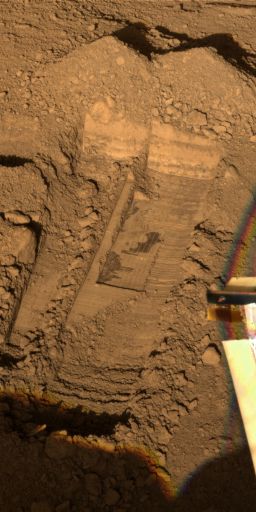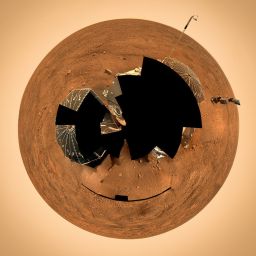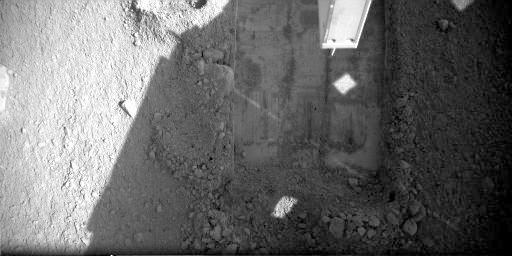Emily Lakdawalla • Jul 02, 2008
Phoenix sol 36 update: Scraping in Wonderland, next steps for TEGA
The Phoenix team is lying somewhat low this week. With Phoenix' sols aligned almost perfectly with Arizona days, the team has to work through the local night, and at least two members of the JPL newsroom team have taken the week off. And an exhausted operations team is being given a much deserved two-day break centered on the Independence Day holiday. I managed to connect briefly with Sara Hammond, the press information officer at the University of Arizona, so I did get a few helpful answers to some of the more obvious questions I had to ask. To follow along, you should check out the SSI raw images page at Texas A&M, my robotic arm camera images page, and my sol-by-sol summary.
So, the last we checked, it was sol 30 on Phoenix, and they held a press conference on the results of the first wet chemistry lab analysis. So this entry will cover the events of sol 31 through 36. In a nutshell:
- They re-imaged Holy Cow on sol 31.
- From sols 31 to 33 Phoenix scraped repeatedly at the "Snow White" trench site, exposing the soil-ice interface and building little dirt piles -- which are named Sorceress -- to take samples from.
- Imaging has been productive; they've been filling in gaps in the "mission success" panorama, also filling in the near field; and on sol 35 they began a panorama of the spacecraft deck.
- It looks like they initially planned to deliver the sample from Snow White both to TEGA and to the wet chemistry lab. However, it looks like they then had second thoughts. According to the latest update, they are actually concerned about the ability of TEGA to avoid short circuits and are planning to treat each sample delivery as though it were the last. Therefore, they will wait to deliver a sample until they have a fresh, ice-rich one (freshly scraped from the ice interface in the Snow White trench), and they will deliver it to oven #0, located opposite from the first oven (oven #4). This won't happen before next week.
- In the meantime, they will likely deliver the now dried-out sample from Wonderland to the optical microscope and, if there's enough left in the scoop, to the wet chemistry lab.
- Phoenix will do lots more imaging while the team is taking their break later this week -- panoramic imaging, atmospheric observations, and monitoring other spots with the robotic arm camera.
- They'll continue also to do atmospheric observations -- humidity and wind and stuff -- with the TECP instrument on the robotic arm. This instrument has NOT yet been used to study the temperature and other properties of the soil, and likely won't be until after the next TEGA delivery. It's not that it hinges on something happening with TEGA -- it's just that getting that ice-rich sample to TEGA is a crucial priority for mission success, and it's trumping the TECP observations for now.

NASA / JPL / UA / Texas A & M / color mosaic by James Canvin
Progress on Phoenix' mission success panorama (the 'Peter Pan') to sol 32
Composed of images taken from sols 0 to 32, this mosaic is one of the mission success requirements for the Phoenix lander. It is shown here at a quarter of its full resolution; for the full-size version, visit James Canvin's website.
NASA / JPL / UA / MPI / color mosaic by hortonheardawho
Phoenix panorama of workspace, sols 34-36
The mosaic is composed of four images taken at each of six spots. Because the images were taken at different times, shadows moved, which is why the shadows across the Wonderland trench (from the SSI camera mast) have color fringes.
NASA / JPL / UA / Texas A & M
Snow White trenches on sol 32
On sol 32, Phoenix used its robotic arm to scrape within the Snow White 2 trench. It used the scraping tool on the underside of its digging arm to smooth out the bottom of the trench, exposing the top of the ice table beneath the soil. (There is no bright ice visible in this image; the mission knows from the texture of the material they are scraping that it is the ice table.) The scraper on the underside of the scoop has several regularly spaced teeth, which carved regularly spaced straight lines into the bottom of the trench.The next sample delivered to NASA's Phoenix Mars Lander's Thermal and Evolved-Gas Analyzer (TEGA) will be ice-rich.A team of engineers and scientists assembled to assess TEGA after a short circuit was discovered in the instrument has concluded that another short circuit could occur when the oven is used again.
"Since there is no way to assess the probability of another short circuit occurring, we are taking the most conservative approach and treating the next sample to TEGA as possibly our last," said Peter Smith, Phoenix's principal investigator.
A sample taken from the trench informally named "Snow White" that was in Phoenix's robotic arm's scoop earlier this week likely has dried out, so the soil particles are to be delivered to the lander's optical microscope on Thursday, and if material remains in the scoop, the rest will be deposited in the Wet Chemistry Laboratory, possibly early on Sunday....
Once the sample is delivered to the chemistry experiment, Smith said the highest priority will be obtaining the ice-rich sample and delivering it to TEGA's oven number zero.
In a few days, the Phoenix team will conduct tests so the instruments can deliver the icy sample quickly, so no materials sublimate, or change from a solid to a vapor, during the delivery process.
The short circuit was believed to have been caused when TEGA's oven number four was vibrated repeatedly over the course of several days to break up clumpy soil delivered to oven number 4. Delivery to any TEGA oven involves a vibration action, and turning on the vibrator in any oven will cause oven number 4 to vibrate as well.
Yikes.
So Phoenix is not out of the woods yet -- until it gets that second, ice-rich sample in to TEGA, it has not met the defined criteria for minimum mission success. The team is now about to take a break, two sols off, during which the spacecraft will be busy taking images. And before you try to ask me why they should take any sols off when Phoenix' life is short, I'll answer that Phoenix may be a robot and able to work at all times around the clock, but its human team is human and by now, a month into the mission, working on Mars time, they must be both physically and mentally exhausted. Getting this TEGA sample right is of critical importance, and they're more likely to do it correctly if they all get just one weekend to recharge and come back to the problem with fresh minds.
Best of luck to the team and try, please, not to turn on your computers for at least 24 hours! You need the rest!
Support our core enterprises
Your support powers our mission to explore worlds, find life, and defend Earth. You make all the difference when you make a gift. Give today!
Donate

 Explore Worlds
Explore Worlds Find Life
Find Life Defend Earth
Defend Earth



